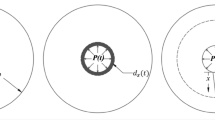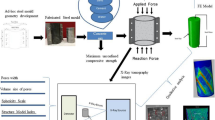Abstract
In this paper a smeared crack modelling approach is used to simulate corrosion-induced damage in reinforced concrete. The presented modelling approach utilizes a thermal analogy to mimic the expansive nature of solid corrosion products, while taking into account the penetration of corrosion products into the surrounding concrete, non-uniform precipitation of corrosion products, and creep. To demonstrate the applicability of the presented modelling approach, numerical predictions in terms of corrosion-induced deformations as well as formation and propagation of micro- and macrocracks were compared to experimental data obtained by digital image correlation and published in the literature. Excellent agreements between experimentally observed and numerically predicted crack patterns at the micro and macro scale indicate the capability of the modelling approach to accurately capture corrosion-induced damage phenomena in reinforced concrete. Moreover, good agreements were also found between experimental and numerical data for corrosion-induced deformations along the circumference of the reinforcement.












Similar content being viewed by others
References
Alonso C, Andrade C, Rodriguez J, Diez JM (1998) Factors controlling cracking of concrete affected by reinforcement corrosion. Mater Struct 45:435–441. doi:10.1007/BF02480466
Andrade C, Alonso C, Molina FJ (1993) Cover cracking as a function of bar corrosion: part I-experimental test. Mater Struct 26:453–464. doi:10.1007/BF02472805
Cabrera JG (1996) Deterioration of concrete due to reinforcement steel corrosion. Cement Concr Compos 18:47–59. doi:10.1016/0958-9465(95)00043-7
Michel A, Pease BJ, Peterova A, Geiker MR, Stang H, Thybo AEA (2013) Penetration of corrosion products and corrosion-induced cracking in reinforced cementitious materials: experimental investigations and numerical simulations. Cem Concr Compos 47:75–86. doi:10.1016/j.cemconcomp.2013.04.011
Molina FJ, Alonso C, Andrade C (1993) Cover cracking as a function of rebar corrosion: part 2—numerical model. Mater Struct 26:532–548. doi:10.1007/BF02472864
Noghabai K (1999) FE-modelling of cover splitting due to corrosion by use of inner softening band. Mater Struct 32:486–491. doi:10.1007/BF02481632
Solgaard AOS, Michel A, Geiker MR, Stang H (2013) Concrete cover cracking due to uniform reinforcement corrosion. Mater Struct 46:1781–1799. doi:10.1617/s11527-013-0016-6
Rendell F, Jauberthie R, Grantham M (2002) Deteriorated concrete: inspection and physicochemical analysis. Thomas Telford Ltd., London
Biondini F, Vergani M (2012) Damage modeling and nonlinear analysis of concrete bridges under corrosion. In: Proceedings of 6th international conference on bridge maintenance, safety and management (IABMAS), Lake Como
Solgaard AOS (2013) Corrosion of reinforcement bars in steel fibre reinforced concrete structures. Dissertation, Technical University of Denmark
Bazant ZP (1979) Physical model for steel corrosion in concrete sea structures—theory. J Struct Div ASCE 105:1137–1153
Bohner E, Müller HS, Bröhl S (2010) Investigations on the mechanism of concrete cover cracking due to reinforcement corrosion. In: Proceedings for FraMCos-7—7th International conference on fracture mechanics of concrete and concrete structures, Jeju
Chernin L, Val DV, Volokh KY (2010) Analytical modelling of concrete cover cracking caused by corrosion of reinforcement. Mater Struct 43:543–556. doi:10.1617/s11527-009-9510-2
Liu Y, Weyers RE (1998) Modeling the time-to-corrosion cracking in chloride contaminated reinforced concrete structures. ACI Mater J 95:675–681
Pease BJ, Michel A, Thybo AEA, Stang H (2012) Estimation of elastic modulus of reinforcement corrosion products using inverse analysis of digital image correlation measurements for input in corrosion-induced cracking model. In: Proceedings of 6th international conference on bridge maintenance, safety and management (IABMAS), Lake Como
Pease BJ, Michel A, Stang H (2012) Quantifying movements of corrosion products in reinforced concrete using X-ray attenuation measurements. In: Proceedings for 2nd international conference on microdurability, Amsterdam
Küter A (2008) Management of reinforcement corrosion. Dissertation, Technical University of Denmark
Koleva DA, Hu J, Fraaij ALA, Stroeven P, Boshkov N, de Wit JHW (2006) Quantitative characterisation of steel/cement paste interface microstructure and corrosion phenomena in mortars suffering from chloride attack. Corros Sci 48:4001–4019. doi:10.1016/j.corsci.2006.03.003
Michel A, Solgaard AOS, Geiker MR, Stang H, Olesen JF (2010) Modeling formation of cracks in concrete cover due to reinforcement corrosion. In: Proceedings for FraMCos-7—7th international conference on fracture mechanics of concrete and concrete structures, Jeju
Skocek J (2010) Fracture propagation in cementitious materials multi-scale approach: measurements and modeling. Dissertation, Technical University of Denmark
Michel A, Pease BJ, Geiker MR, Stang H, Olesen JF (2011) Monitoring reinforcement corrosion and corrosion-induced cracking using non-destructive X-ray attenuation measurements. Cem Concr Res 41:1085–1094. doi:10.1016/j.cemconres.2011.06.006
Val DV, Chernin L, Stewart MG (2009) Experimental and numerical investigation of corrosion-induced cover cracking in reinforced concrete structures. J Struct Eng 135:376–385. doi:10.1061/(ASCE)0733-9445(2009)135:4(376)
Thybo AEA, Michel A, Stang H (2013) Modeling of corrosion-induced concrete damage. In: Proceedings for FraMCos-8—8th international conference on fracture mechanics of concrete and concrete structures, Toledo
Michel A, Pease BJ, Peterova A, Geiker MR (2012) Experimental determination of the penetration depth of corrosion products and time to corrosion-induced cracking in reinforced cement based materials. In: Proceedings of international congress on durability of concrete, Trondheim
Gebreyouhannes E, Maekawa K (2016) Nonlinear gel migration in cracked concrete and broken symmetry of corrosion profiles. J Adv Concr Technol 14:271–286. doi:10.3151/jact.14.271
Concrete Structures, DS/S-19000 Eurocode (2008) Eurocode 2: design of concrete structures—Part 1-1: general rules and rules for buildings
Vu K, Stewart MG, Mullard J (2005) Corrosion-induced cracking: experimental data and predictive models. ACI Struct J 102:719–726
GOM (2009) Aramis user manual—Software, Aramis v6.1 and higher. GOM Optical Measuring Techniques
Pease BJ, Geiker MR, Stang H, Weiss WJ (2006) Photogrammetric assessment of flexure induced cracking of reinforced concrete beams under service loads. In: Proceedings of the second international RILEM symposium: advances in concrete through science and engineering, Québec City
Pereira EB, Fischer G, Barros JA (2011) Image-based detection and analysis of crack propagation in cementitious composites. In: Proceedings of international RILEM conference on advances in construction materials through science and engineering, Hong Kong
Care S, Nguyen QT, L’Hostis V, Berthaud Y (2008) Mechanical properties of the rust layer induced by impressed current method in reinforced mortar. Cem Concr Res 38:1079–1091. doi:10.1016/j.cemconres.2008.03.016
Ouglova A, Berthaud Y, Francois M, Foct F (2006) Mechanical properties of an iron oxide formed by corrosion in reinforced concrete structures. Corros Sci 48:3988–4000. doi:10.1016/j.corsci.2006.03.007
Acknowledgements
The authors gratefully acknowledge the financial support of the Danish Expert Centre for Infrastructure Constructions. Further, the authors would like to thank Bradley J. Pease for contributing with experimental data.
Funding
The first author has received funding from the Danish Expert Centre for Infrastructure Constructions. No grant number exists.
Author information
Authors and Affiliations
Corresponding author
Ethics declarations
Conflict of interest
The authors declare that they have no conflict of interest.
Rights and permissions
About this article
Cite this article
Thybo, A.E.A., Michel, A. & Stang, H. Smeared crack modelling approach for corrosion-induced concrete damage. Mater Struct 50, 146 (2017). https://doi.org/10.1617/s11527-017-0999-5
Received:
Accepted:
Published:
DOI: https://doi.org/10.1617/s11527-017-0999-5




